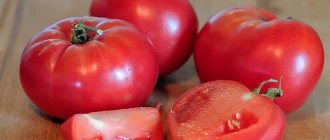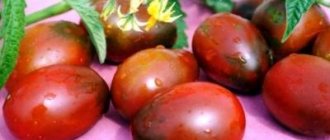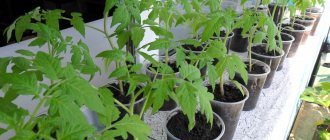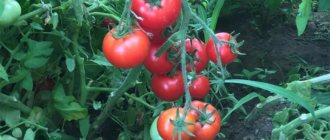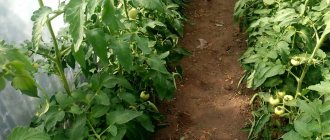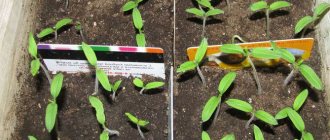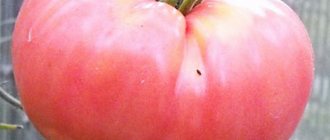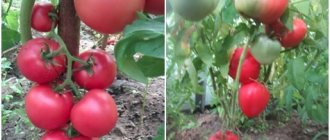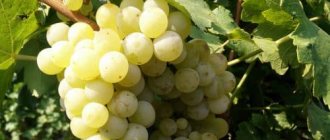Description of the variety
The tomato is a medium-late variety - at least 120-130 days pass from the transfer of seedlings to the greenhouse to the appearance of ripe tomatoes.
An indeterminate non-standard bush grows up to 2-3 meters in height.
Tomatoes of the “De Bareo Red” variety need to be tied to supports. The branches of the hybrid should be supported so that they do not break off under the weight of the tomatoes.
REFERENCE: The plant is planted mainly in high greenhouses so that the branches are not damaged.
Description of the fruit “De Barao Red”:
- Excellent taste;
- Ripe tomatoes are bright red in color;
- Elongated shape, reminiscent of cream;
- The weight of the fruit is from 80 to 120 grams;
- Number of seed chambers – 2 or 3;
- Good keeping quality;
- Thick skin;
- Juicy pulp of dense consistency;
- Dry matter content –5-6%;
- Possibility of transportation.
Description and characteristics of tomato De Barao, reviews, photos
This is a very popular, mid-late , tall variety for greenhouses and open ground.
Bushes of indeterminate type, up to 2.5 meters high and above . They require tying them to a support or trellis and pinning them.
It is best to form such tall tomatoes in 1 or 2 stems. In the first case, all the stepsons (side shoots growing from the axils of the leaves) are removed, in the second, 1 stepson is left, located under the first flower cluster (this will be the second stem).
The leaves of this tomato are large and green. The inflorescence is simple and intermediate. The first inflorescence is laid above the 9-11th leaf, the subsequent ones - every 3 leaves.
Basic qualities of fruits
The fruits are plum-shaped, weighing 70-90 grams , dense, red at maturity, juicy, good taste.
Not prone to cracking (even during heat treatment), durable and transportable. These tomatoes are universal - good for whole-fruit canning, fresh consumption, and drying. Productivity of De Barao tomato : up to 3.5 kg of fruit from 1 plant (subject to agricultural practices, watering and fertilizing).
Advantages of the variety : stable yield, high taste of fruits, their suitability for canning.
A site about tomato varieties with truthful reviews from gardeners - Tomatland.
Tomatoes: advantages and disadvantages
The main advantages of the variety “De Barao Red”:
- Plants give an excellent harvest;
- Tomatoes tolerate shady places well;
- Good resistance to temperature changes;
- Beautiful view of ripe tomatoes;
- Balanced pulp composition;
- Versatility in the use of fruits;
- Immunity to many diseases and pests;
- Possibility of transporting fruits over long distances.
Overview of De Barao's species:
Separately, the disadvantages of tomatoes should be noted:
- Suitable for planting only in high greenhouses;
- Plants do not combine well with other tomato varieties;
- The branches of the bushes need pruning.
In regions with cold temperatures in the summer, the De Barao Red variety is grown exclusively in greenhouse conditions.
De Barao tomatoes on video
If you grew De Barao tomatoes, please write what the yield and taste of the fruit was in your conditions. How do you rate the disease resistance of this tomato? Briefly describe the advantages and disadvantages of this tomato in your opinion. If possible, attach to the comment a photo of the entire bush as a whole or individual fruits that you grew. Do you have any agricultural secrets for tomatoes?
Your feedback on the De Barao tomato and additions to the description will help many gardeners evaluate this variety more objectively and decide whether it is worth planting or not.
If you are interested in seeing other varieties of tomatoes suitable for pickling, we recommend going to the section Tomatoes for pickling
A website about tomatoes is always at your service - Tomatland.
Growing tomatoes
The variety "De Barao Red" is grown by seedlings.
How to prepare seeds?
For planting, dense seeds that are not damaged by fungus and insect pests are selected. For better germination, the seed is treated with growth stimulants.
Sowing seed material
It is recommended to plant seeds for seedlings in March. Pre-prepared shallow containers are filled with a nutrient mixture, which should consist of half a standard bucket of soil and the same amount of humus (deciduous or manure).
The soil should be slightly moistened and the seeds should be planted at a distance of 1.5-2 cm from each other.
A layer of soil substrate of approximately 0.8 cm should be poured on top of the seeds.
Sowing must be covered with thin glass or plastic film to retain moisture in the soil and warm it up.
Containers with future seedlings are placed in a warm place. Systematic ventilation of the crops is also carried out.
After germination, the covering is removed and the containers are placed in a well-lit place.
Seedlings must be watered regularly. 21 days after emergence, it is recommended to fertilize with organic matter or mineral fertilizers.
Picking is carried out after two true leaves appear on the seedlings.
Rules for planting seedlings
Seedlings of the review variety are planted depending on the cultivation region and growing method. Plants are planted under film and in greenhouses in May, and in open ground in early June.
The seedlings must be 55-60 days old and have at least five true leaves. The recommended seedling planting pattern is 50 by 55 cm.
After planting the plants, water the holes with a small amount of warm water.
IMPORTANT: To protect plants from blackleg, the soil should be sprinkled with sifted ash.
The best variety for preservation
De Barao appeared on Russian territory back in the 90s; he is originally from Brazil. Today, different varieties of tomato have been bred that have similar characteristics, but differ in the description of the fruit (different weight and color).
The tall giant grows in greenhouses up to 2-3 meters, the bush is powerful, with spreading branches. The foliage is medium, the leaves are medium-sized, dark green in color.
In terms of ripening time, it is a late-ripening tomato, so in regions with harsh climates it is grown only in greenhouses. The first tomatoes are removed from tomato bushes 120-125 days after emergence; fruiting lasts for a long time, until late autumn.
ON A NOTE! When growing De Barao tomatoes, take into account the tall growth of the plant and select the appropriate shelter height.
The first flower cluster is formed after the 9th leaf, then the inflorescences go through three leaves. One cluster contains 7-10 oval-shaped fruits.
The color depends on the variety and, taking into account the photo and description, they choose black, gold, red, orange or pink De Barao for growing. The weight of each tomato is 80-100 grams, the skin and pulp are dense, and there are two chambers inside. The fruits contain a large number of seeds, so, if desired, in any season, gardeners collect seed material for subsequent planting.
The taste is high, and unlike hybrid forms of tomatoes, everyone likes tomatoes of this variety. They are ideal for canning and pickling. In marinade and brine they do not lose their shape, do not crack, and are very tasty.
They are used for cutting, for sandwiches, and for decorating holiday dishes. Tomatoes are picked at a state of technical ripeness; they then ripen perfectly at home. Shelf life is up to 2-2.5 months without loss of taste and presentation.
Bush care
To plant a hybrid, you must choose a well-lit area. The bush is usually formed into 1-2 stems. The plant must be tied to a strong support. The branches should also be supported, as they may break under the weight of the fruit.
Basic rules for caring for the De Barao Red hybrid:
- Tall tomatoes are watered only at the root;
- Watering is carried out with warm water in the evening;
- Plants need regular feeding (at least three times per season) with organic matter and complex mineral fertilizers;
- Mandatory loosening of the soil;
- The bushes need pinching.
After the fruits form on the bush, the lower leaves should be removed.
Variety varieties
The De Barao tomato variety comes in several varieties. Each option requires compliance with its own specific rules and growing conditions.
De Barao black
A very handsome representative of the De Barao family. The bush is indeterminate, has a simple inflorescence. Brown fruits become fully ripe when the green spot on the stalk completely disappears.
Tomato De Barao black
The black De Barao bush must be pruned. The taste is excellent. From 1 meter you can harvest up to 10 kg of tomatoes. Suitable for canning even in whole form.
Attention! If the basic growing rules are followed, the variety is not susceptible to late blight.
De Barao pink
This variety has the lowest yield of all De Barao representatives. It is very difficult to get even 5 kg of berries from a pink tomato bush. It performs best indoors. The tomato has a thick skin, weighing 50-70 grams.
Tomato De Barao pink
De Barao the giant
The largest representative of this variety. The main characteristic is that it is the latest ripening, as it has very large fruits - from 220 grams.
Diseases and pests
The hybrid is highly resistant to a large number of diseases. However, bushes can be damaged by black bacterial spot. When plants become infected, they are treated with the drug “Fitolavin”.
Tomatoes can also be affected by blossom end rot. In this case, the tomatoes are sprayed with a solution of calcium nitrate. You should also limit watering the area.
Among the pests, the bush is often damaged by Colorado potato beetles and slugs.
Insects are collected by hand, and the tomatoes are sprayed with the Prestige preparation.
A folk remedy will help get rid of gastropods. A tablespoon of dry mustard or red hot pepper is diluted in 10 liters of water. The resulting solution is used to water the soil in the beds with tomatoes.
Description of fruits
These tomato bushes are not very large, but have strong side shoots. The fruits are not large, oblong in shape, weighing from 55 to 80 grams. The plant begins to bear fruit four months after the first planting of seeds, which is why its fruits are considered medium-late. This type of tomato has good yield. For example, from one square meter of land you can collect from seven and a half to nine kilograms of fruit. The beautiful rich color of tomatoes, as well as their sweetish taste, are also attractive.
According to the description, De Barao tomatoes are divided into several types depending on the color of the fruit. Gardeners grow red, black, pink and yellow varieties of the tomato in question. The De Barao Tsarsky tomato is especially popular among consumers. This type of fruit is a rare species, so if you want to grow them in your garden, contact collectors who will help you purchase seeds via mail or the Internet. The royal tomato is characterized by large pink-raspberry fruits, weighing up to one hundred and thirty grams.
This variety is distinguished by the number of fruits on one cluster, usually up to ten units. If you follow all the rules for growing, you can collect from ten to fifteen kilograms of fruit from one plant. De Barao Tsarsky is resistant to cold weather and is not afraid of sub-zero weather, which allows harvesting until the onset of the first frost. It is these tomatoes, like no other type, that are excellent for the production of tomato paste and juice.
Variety advantage
Red De Barao tomatoes are popular among vegetable growers not only because of their taste and good yield, but also because they do not require complex growing methods. These tomatoes have a number of advantages that distinguish them from other varieties.
- The amount of crop grown per square meter significantly exceeds the yield of other tomatoes.
- One lash grows from 8-9 fruits.
- Ease of plant care and immunity of tomatoes to various diseases that often affect all vegetable crops.
- The attractive appearance and small size of the fruit, which certainly pleases every housewife who is interested in canning.
- It is easy to grow De Barao red both in a greenhouse and in open ground.
Another advantage is that the vegetable can be used in cooking in any way. These tomatoes make wonderful salads and snacks, delicious ketchups and tomato pastes. They are ideal for preserving and preparing various pickles.
Productivity
The hybrid is characterized by high productivity. 4-5 kg of ripe fruits are collected from the bush. In some cases, this figure is 6 kg. When planting three plants per 1 sq. meter, the average yield is about 15 kg.
Which regions are best to grow in?
In unprotected soil, the review variety is grown mainly in the southern regions. The Crimea, Krasnodar Territory, and Astrakhan Region are excellent for tomatoes. In central Russia, the hybrid grows in greenhouses.
Features of cultivation
“De Barao Pink” is very unpretentious in cultivation and, with good support, grows to gigantic sizes: up to 2 meters. The plant tolerates shade and temperature changes well. Forms beautiful rich clusters of fruits that require garter.
If this type of tomato is grown in open ground, then only the southern regions are suitable for this. This variety can be grown in greenhouses in the regions of central Russia. Colder regions are not suitable for this type of tomato.
“De Barao Pink” responds well to fertilizing with mineral fertilizers. During active growth, abundant watering is needed. It produces a friendly ovary and bears fruit for a very long time until severe cold weather.
Read useful articles about fertilizers for tomatoes:
- Organic, phosphorus, complex and ready-made fertilizers for seedlings and the TOP best.
- Yeast, iodine, ammonia, hydrogen peroxide, ash, boric acid.
- What is foliar feeding and when picking, how to carry it out.
Growing seedlings: step-by-step instructions
When should I plant seeds for seedlings? You can do this from the first days of March. But if tomatoes will grow in open ground, it is better to postpone this until the first days of April. There is no need to rush into planting seedlings; if you plant seeds in February, there is a risk that the plants will freeze later when the temperature drops at night.
On a note! It is very convenient to store bags of seeds in a regular photo album. This is especially true if you plan to grow several varieties of tomatoes. The planted seeds can be marked with a number, the same number can be placed on the seed packaging, and then the bag can be stored in a photo album.
Step 1. Germinate seeds on toilet paper.
Before starting work you need to prepare:
- non-foil laminate backing 2 mm thick;
- good quality toilet paper, preferably two or three layers;
- syringe;
- drug "Epin";
- warm water – 0.5 – 1 l;
- sharp knife;
- stationery erasers or tape.
Laminate underlay is sold in rolls. From this roll it is necessary to cut a tape 14-16 cm wide. It is most convenient to measure the required width from the edge of the roll, mark it with a marker, and then cut with a knife without unrolling the roll in advance.
The cut tape must be placed on the table. It is advisable to cover the table with oilcloth in advance or place a large spacer for work.
The edge of the backing tape must be aligned with the edge of the toilet paper roll, then roll both to the edge of the table or slightly less.
Epin needs to be diluted in water. For 0.5 liters – 2-3 drops of the drug. The solution should be mixed well and collected into a syringe.
From the syringe, the solution must be poured evenly onto the toilet paper so that it is well saturated.
Now you can start laying out the seeds. It is recommended to grab them one at a time with tweezers or a wet toothpick and place them on paper, retreating 5 cm from the short edge of the substrate, 1.5 cm from the top and maintaining an interval of 1-3 cm between the seeds.
When all the seeds have been planted, all that remains is to cut off the excess backing and then roll the tape into a tight roll that can be secured with an elastic band or tape.
On a note! If there are a lot of prepared rolls, they should be placed vertically (seeds up) in a plastic fruit box. If there is only one roll of seeds, a food container or 0.5 liter plastic glass will do.
The rolls should be covered with cling film, a garbage bag or other similar material, and then the box (glass) should be stored in a warm place for three days. During this period, the seeds do not need light.
After three days, you need to check how well the tomatoes are sprouting. The film must be removed and the rolls unrolled one by one on the table. If the seeds have hatched and green loops appear, you can move on to the next stage of work.
Step 2. Growing seedlings in rolls.
There is no need to remove hatched seeds from toilet paper. You need to pour a two-centimeter layer of loose soil directly onto the toilet paper with a spoon or spatula.
On a note! It is recommended to use a mixture of garden soil from the garden bed and humus (proportion 2 to 1) as soil. There should be no large lumps, debris or mold in the soil.
It’s okay if the sprouted seeds are covered with soil. For convenience, it is worth pouring soil and twisting the roll at the same time.
When the entire “snail” is covered with soil, rolled up and secured with an elastic band, it needs to be placed vertically, and more earth should be added on top so that it covers all the turns of the roll.
It is advisable to place the roll in a box with a layer of sawdust at the bottom. This material absorbs and retains moisture well, providing comfortable conditions for seedling growth.
Important! There is no need to water the sawdust.
The box needs to be closed again with a bag and put in a warm place. You can open the box when green shoots appear from the soil. After this, the seedlings need to be moved to a bright place, for example, on a windowsill, or a rack for seedlings.
Step 3. It is advisable to water the seedlings with a syringe, without eroding the soil.
Step 4. Picking seedlings.
You can plant seedlings in any container - cups, toilet paper rolls, boxes. But it is most convenient to plant seedlings in “diapers” made of film. Plastic food packaging bags are perfect for this.
You can pick seedlings when the plants have 2-4 true leaves.
On a note! If you do not want to pick seedlings, then the seeds should initially be laid out on toilet paper at intervals of 10-15 cm.
The procedure for diving from the “snail” to the “diaper” is as simple as possible:
- the roll with seedlings is placed on the table, the fixing rubber band or adhesive tape is removed;
- The edge of the roll is unrolled. It is enough to bend the edge 15-20 cm;
- the first package is spread on the table;
- The first sprout along with a lump of earth is removed from the “snail” with a spatula, being careful not to damage the root system. The sprout is transferred to a spread bag;
- the sprout is covered with one or two tablespoons of soil so that it covers the root and stem up to the cotyledon leaves;
- The bottom of the bag is folded, after which the edges are twisted around the root filled with soil. The edges can be secured with a piece of tape.
Seedlings in “diapers” are placed in fruit boxes close to each other.
Step 5. Hardening off the seedlings.
When the picked seedlings are strong enough, they can be taken out to a polycarbonate greenhouse and covered with covering material. If this is not possible, the seedlings can be hardened off on the balcony or on the window, opening the window first briefly, then increasing the ventilation time to 2-3 hours.
After hardening, seedlings become stronger, less whimsical, and “immunity” to sudden changes in air temperature during the summer is formed.
Transplanting seedlings into a greenhouse
Tall De Barao bushes are shade-tolerant, but you should not overshade the plants, as this will affect their growth rate and the amount of harvest. It is optimal if there is from 90 to 120 cm of free space between neighboring bushes.
It is advisable to prepare the beds in advance by digging up the soil and adding humus to it. In order for the soil to warm up better, 3-5 days before planting the seedlings, the bed can be covered with black film.
Seedlings are planted when the air warms up to +20... +22°C during the day, and at least to +15°C at night.
On one square meter of beds, only two holes are made. It is advisable to add a tablespoon of ash to the hole. The sprout in the hole is placed vertically, without tucking in the roots, after which it is sprinkled with earth and watered generously around the stem.
On a note! During the first two weeks after planting the seedlings in the greenhouse, acclimatization and rooting occur. During this period, it is recommended to add Superphosphate fertilizer to the soil.
Pegs for gartering bushes are driven in simultaneously with planting seedlings in the ground. If this activity is carried out later, damage to the root system is possible, which is extremely undesirable for plants.
Further care
Tomatoes of the de Barao variety are considered unpretentious, so even novice gardeners will not have problems. It is important to follow agricultural practices; this directly affects the yield and quality of the fruit. Caring for tomatoes consists of several stages:
- regular watering. Pink tomatoes love abundant watering, but do not over-moisten the soil: this will quickly cause the root system to rot. Water the plants only when they dry out and use cool, settled water at the root. Sprinkling is not carried out. It is necessary to avoid moisture getting into the leaf sinuses, this leads to the formation of rot;
- stepsoning. Indeterminate plants need formation. To achieve maximum yield from the variety, all stepsons are pruned. The plant grows in one or two stems. During the formation of ovaries, the lower leaves are cut off. This will ensure better ventilation and faster fruit growth;
- fertilizing De Barao is responsive to fertilization. When transplanting seedlings to a permanent place, add ash to the ground (a glass per 1 m2). The ash contains many microelements necessary for the full development of the plant. 2-3 weeks after transplantation, the bushes are fed with nitrogen additives: ammonium nitrate, nitrophoska. Nitrogen is necessary for the formation of strong stems. For abundant fruiting, potassium and phosphorus supplements are used. Their use has a positive effect on the taste of fruits.
On a note! After watering, when the water is absorbed, the soil can be loosened with a hoe or rake. The soil is saturated with oxygen, and it is needed for the formation of roots. A hard, impenetrable crust should not be allowed to form on the soil.
